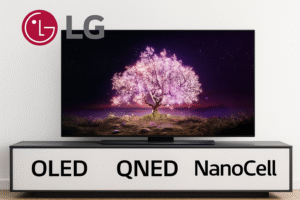Design and Build Quality
When it comes to design and build quality, LG consistently delivers products that are both stylish and durable. Whether you’re looking at LG TVs, smartphones, or home appliances, the company emphasizes sleek aesthetics paired with long-lasting materials.
LG TVs are known for their ultra-slim profiles and nearly bezel-less displays. The use of premium materials like brushed aluminum and high-quality plastics gives their televisions a modern, minimalist appeal that fits seamlessly into any living room.
LG smartphones, though now limited in production, were once praised for their innovative designs—like curved screens (LG G Flex) and modular components (LG G5). Even today, many users still appreciate the bold design choices LG made in the mobile space.
In the home appliance category, LG refrigerators, washing machines, and microwaves combine practicality with polished exteriors. Stainless steel finishes, intuitive control panels, and ergonomic handles are standard features, reflecting LG’s attention to user comfort and aesthetics.
LG also focuses on build reliability. Products are engineered for everyday use, and many customers report years of consistent performance. The brand’s commitment to quality control helps minimize issues related to wear and tear over time.
Recommended image placement:
-
Image of an LG OLED TV in a modern living room (showcasing slim design)
-
Close-up photo of LG appliance finishes (like stainless steel refrigerator handles)
-
Comparison photo: LG smartphone design next to a competitor’s device (optional, historical)
Display and Visual Performance
LG is a leader in display technology, known for producing screens with excellent color accuracy, sharpness, and contrast. From LG TVs to monitors, LG’s displays are designed to deliver an immersive viewing experience for both everyday users and professionals.
OLED Technology
One of LG’s most impressive advancements is OLED (Organic Light Emitting Diode). Unlike traditional LED screens, OLED does not require a backlight. Each pixel emits its own light, which allows for true black levels, rich colors, and excellent contrast. This makes LG OLED TVs perfect for watching movies, gaming, or any content that demands high visual quality.
Recommended image placement:
-
A comparison image showing an LG OLED screen next to a traditional LED TV, highlighting deeper blacks and brighter colors
QNED and NanoCell Displays
For those looking for alternatives to OLED, LG also offers QNED and NanoCell technologies. QNED combines quantum dots with NanoCell particles and Mini LED backlighting. The result is brighter images, better contrast, and more accurate colors—even in brightly lit rooms.
NanoCell displays use nano-sized particles to filter out dull colors, enhancing picture quality and producing more vibrant, lifelike images. These options give customers a range of choices depending on budget and viewing preferences.
Recommended image placement:
-
Side-by-side visuals of LG QNED and NanoCell screens, displaying bright, colorful scenes like nature or cityscapes
Monitors and Other Displays
In addition to TVs, LG also produces high-quality monitors, especially the LG UltraFine series. These are popular among photographers, designers, and video editors due to their high resolution and color precision.
Though LG no longer manufactures smartphones, its past mobile displays—particularly OLED and IPS LCD panels—were praised for sharp visuals and wide viewing angles.
Recommended image placement:
-
A desktop setup featuring an LG UltraFine monitor with creative software open, illustrating clarity and color detail
Performance and Speed
LG products are designed not just to look good but also to perform efficiently. Whether you’re using an LG TV, home appliance, or computer monitor, the brand emphasizes speed, responsiveness, and reliability.
LG TVs and Processors
LG’s latest TVs feature α (Alpha) series processors, such as the α9 Gen6 AI Processor, which optimize picture and sound quality in real time. These processors analyze content frame by frame, reducing noise, sharpening images, and improving contrast. This results in smooth motion, fast response times, and an enhanced viewing experience, especially when streaming high-resolution video or gaming.
Recommended image placement:
-
Visual diagram of the LG α9 processor highlighting its role in improving TV performance (motion smoothing, AI enhancements, etc.)
LG Home Appliances
In home appliances, LG’s Inverter technology is a key factor in performance and energy efficiency. For example, LG washing machines use Direct Drive Motors, which operate quietly and efficiently, adjusting speed based on load type. LG refrigerators with Smart Inverter Compressors cool quickly and maintain stable temperatures, improving food preservation and saving energy.
Recommended image placement:
-
Internal graphic of an LG washing machine or refrigerator showing the inverter motor or compressor in action
Monitors and Multitasking
For professionals, LG UltraGear and UltraFine monitors are built for speed and precision. UltraGear gaming monitors support high refresh rates (up to 240Hz) and low input lag, making them ideal for competitive gaming. UltraFine monitors support seamless multitasking with fast response times and high processing power for graphic-heavy workloads.
Recommended image placement:
-
A side-by-side setup: an LG UltraGear monitor displaying a fast-paced game next to an UltraFine monitor used for creative work
Smart Features and Connectivity
When choosing a modern device, smart features and connectivity are essential factors to consider. These elements enhance convenience, efficiency, and the overall user experience—and LG excels in this area.
What Are Smart Features?
Smart features refer to advanced functionalities that make devices more intuitive and user-friendly. LG integrates smart technology across its TVs and appliances with features such as:
-
AI-powered voice assistants, including LG ThinQ, with support for Google Assistant and Amazon Alexa
-
Remote control via the LG ThinQ app, enabling users to manage appliances and TVs from their smartphones
-
Smart automation features that adapt settings based on usage patterns and environmental factors
-
Personalized settings that tailor content, wash cycles, or cooling preferences to each user
These smart features allow LG users to interact with their devices in more intelligent and efficient ways.
Connectivity Options
LG products are designed to fit into any connected lifestyle with modern connectivity options such as:
-
Wi-Fi and Bluetooth, ensuring seamless integration with other smart home devices
-
LG ThinQ ecosystem, which connects multiple LG devices into a unified network for easier management
-
HDMI, USB, and wireless casting options that make media sharing and multitasking easy on LG TVs and monitors
Recommended image placement:
-
Screenshot of the LG ThinQ app interface showing connected devices
-
Family using voice control with an LG smart TV or smart fridge
-
Diagram of a smart home setup featuring multiple connected LG devices

Importance of Connectivity
Connectivity is the backbone of smart features. Devices that support Wi-Fi, Bluetooth, and other wireless technologies can easily connect to home networks and other smart devices. This seamless integration enables users to control their devices remotely, receive real-time updates, and automate tasks.
Benefits of Smart Features and Connectivity
-
Remote Access: Control your devices from anywhere using your smartphone.
-
Automation: Set schedules or routines for your devices to operate automatically.
-
Integration: Easily connect with other smart devices for a unified experience.
-
Efficiency: Save time and energy with personalized and automated settings.
Energy Efficiency and Environmental Impact
Energy efficiency and environmental impact are closely linked, making energy efficiency a key focus for anyone interested in sustainability and responsible energy use.
what is energy efficiency?
Energy efficiency means using less energy to perform the same task or produce the same result. By optimizing energy use, we reduce waste and lower overall consumption, which leads to significant environmental benefits.

Environmental Impact of Energy Efficiency
Improving energy efficiency directly reduces greenhouse gas (GHG) emissions by decreasing the demand for energy from fossil fuel sources such as coal, oil, and natural gas. This helps combat climate change, improves air and water quality, and preserves ecosystems and biodiversity. If all cost-effective energy efficiency measures were implemented globally, annual energy-related emissions could be reduced by 3.5 gigatonnes of CO₂ equivalent compared to 2017 levels, delivering over 40% of the abatement needed to meet the Paris Agreement targets.
Broader Benefits
- Resource Conservation:
Using less energy means less demand for raw materials and fuels, reducing strain on natural resources and habitats. - Pollution Reduction:
Efficient energy use minimizes air and water pollution, safeguarding environmental and public health. - Cost Savings:
Energy-efficient technologies lower energy bills for consumers and businesses. - Sustainable Development:
Energy efficiency supports a sustainable future by balancing human activities with environmental preservation.
How to Improve Energy Efficiency
-
Upgrade to energy-efficient appliances and lighting.
-
Use smart thermostats and controls.
-
Insulate buildings to reduce heating and cooling needs.
-
Adopt renewable energy sources where possible.
Customer Reviews and User Experience
Customer reviews and user experience are pivotal in shaping a business’s reputation and influencing buying decisions. Together, they provide authentic insights into how products or services perform in real life, helping potential customers make informed choices.
Importance of Customer Reviews
Customer reviews serve as social proof, greatly impacting consumer trust and purchase behavior. About 9 out of 10 users have made buying decisions based on online reviews, and 85% of consumers trust these reviews as much as personal recommendations. Positive reviews can boost sales by up to 31%, with products having five or more reviews being 270% more likely to be purchased. Conversely, 94% of consumers avoid businesses after reading negative reviews, highlighting the critical need for maintaining a positive online reputation.
Role of User Experience
User experience (UX) encompasses how customers interact with a product or service, including ease of use, satisfaction, and overall impression. A positive UX encourages repeat purchases and customer loyalty. Studies show that 89% of consumers are more likely to buy again after a positive customer service experience1. Good UX also reduces frustration and increases engagement, which can translate into higher conversion rates.
Impact of Business Responses to Reviews
Responding to customer reviews, especially negative ones, can significantly improve user perception. About 56% of consumers change their opinion about a business after seeing a response to their review, and 45% are more likely to visit a business that actively replies to negative feedback25. Timely and thoughtful responses demonstrate that a business values customer feedback and is committed to resolving issues.
Authenticity and Trust
Consumers are increasingly wary of fake reviews, with 62% expressing concerns about AI-generated or fraudulent feedback6. Reviews that include customer photos or detailed experiences are seen as more trustworthy, boosting credibility. Transparency and authenticity in reviews are essential to build long-term customer trust.
Summary
-
Customer reviews strongly influence buying decisions and brand reputation.
-
Positive user experience fosters loyalty and repeat business.
-
Active engagement with reviews improves customer perception and trust.
-
Authentic, transparent reviews are critical in today’s digital marketplace.
Price and Value for Money
When considering any product or service, price and value for money are two crucial factors that consumers evaluate. Price refers to the amount of money required to purchase an item, while value for money measures how much benefit or satisfaction the consumer gets relative to that price.
A low price doesn’t always mean good value. Sometimes, paying more upfront for higher quality or energy-efficient products can save money in the long run through durability, lower maintenance costs, or reduced energy bills. Conversely, the cheapest option might cost more over time due to poor performance or early replacement needs.
To maximize value for money, consumers should consider both the initial price and the overall benefits, including quality, longevity, efficiency, and after-sales service. Making informed choices ensures that spending delivers the best possible return.

